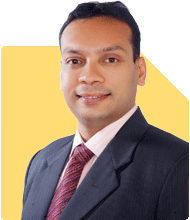41 Year Old Aiming for 5 Lakh Monthly Income and 50 Crore Corpus at 80 - How Realistic?
Ramalingam Kalirajan |6501 Answers |Ask -Follow
Mutual Funds, Financial Planning Expert - Answered on Aug 02, 2024
He has an MBA in finance from the University of Madras and is a certified financial planner.
He is the director and chief financial planner at Holistic Investment, a Chennai-based firm that offers financial planning and wealth management advice.... more

Hi Jinal, My current age is 41 and doing monthly mutual fund sip of 40k and step up of 5k. My current assets is Mutual fund portfolio 30 lacs Pf 25 lacs PPF 15 lacs Equity 25 lacs Ulip insurance 5 lacs I need monthly income of 5 lacs at 55age and corpus of atleast 50crore at 80age. Please share your thoughts on possible corpus and monthly income possible plan
Current Financial Overview
Mutual Fund Portfolio: Rs. 30 lakhs
Provident Fund (PF): Rs. 25 lakhs
Public Provident Fund (PPF): Rs. 15 lakhs
Equity Investments: Rs. 25 lakhs
ULIP Insurance: Rs. 5 lakhs
You also have a monthly SIP of Rs. 40k with a step-up of Rs. 5k. This is a strong foundation.
Step 1: Review and Optimize Current Investments
Mutual Funds
Actively managed funds can yield better returns than index funds. Shift from index funds to well-performing actively managed funds. These funds have professional fund managers. They can make strategic decisions to maximize returns.
Equity Investments
Direct equity investments can be volatile. Ensure you diversify across sectors. This will reduce risk and enhance returns.
ULIP Insurance
ULIPs often have high charges and low returns. Consider surrendering this policy. Reinvest the proceeds into mutual funds.
Provident Fund (PF) and PPF
These are stable, low-risk investments. They provide tax benefits and assured returns. Continue contributing to these.
Step 2: Diversify Your Portfolio
Balanced Funds
These funds invest in both equity and debt. They provide stability and growth. Allocate a portion of your SIP to balanced funds.
Sectoral/Thematic Funds
These funds can provide high returns. They invest in specific sectors like technology or healthcare. Allocate a small portion here for higher returns.
Debt Mutual Funds
Debt funds offer stability. They are less volatile than equity funds. Include these in your portfolio to manage risk.
Step 3: Increase Investments Gradually
SIP Step-Up
You are already stepping up your SIP by Rs. 5k. Continue this practice. It will help in growing your corpus faster.
Lump Sum Investments
Invest any windfall gains or bonuses as lump sums. This will boost your corpus.
Step 4: Tax-Efficient Investments
Equity-Linked Savings Scheme (ELSS)
ELSS funds offer tax benefits under Section 80C. They also provide good returns. Include ELSS in your portfolio.
National Pension System (NPS)
NPS provides tax benefits and is a good retirement planning tool. It is a low-cost investment option.
Step 5: Risk Management
Life Insurance
Ensure you have adequate term life insurance. This protects your family financially in case of any mishap.
Health Insurance
Have comprehensive health insurance. This covers medical emergencies and reduces financial burden.
Step 6: Regular Portfolio Review
Annual Review with CFP
Review your portfolio annually with a Certified Financial Planner. This helps in realigning your investments based on market performance and your goals.
Rebalance Your Portfolio
Rebalance your portfolio to maintain the desired asset allocation. This helps in optimizing returns and managing risk.
Step 7: Projected Income and Corpus
Monthly Income at Age 55
To achieve Rs. 5 lakhs monthly income at age 55, aim for a substantial retirement corpus. Invest in a mix of equity, balanced, and debt funds. Consider a systematic withdrawal plan (SWP) from mutual funds post-retirement.
Corpus of Rs. 50 Crores at Age 80
Aiming for Rs. 50 crores at age 80 requires disciplined investing. Continue your SIPs, increase contributions, and diversify wisely.
Finally
Achieving your financial goals is possible with a disciplined and strategic approach. Diversify your investments, increase contributions, and seek professional guidance. Regularly review and rebalance your portfolio to stay aligned with your goals.
Best Regards,
K. Ramalingam, MBA, CFP,
Chief Financial Planner,
www.holisticinvestment.in
You may like to see similar questions and answers below
Ramalingam Kalirajan |6501 Answers |Ask -Follow
Mutual Funds, Financial Planning Expert - Answered on May 26, 2024
Ramalingam Kalirajan |6501 Answers |Ask -Follow
Mutual Funds, Financial Planning Expert - Answered on Jul 12, 2024
Ramalingam Kalirajan |6501 Answers |Ask -Follow
Mutual Funds, Financial Planning Expert - Answered on Aug 13, 2024
Dr Dipankar Dutta |653 Answers |Ask -Follow
Tech Careers and Skill Development Expert - Answered on Oct 04, 2024
Krishna Kumar |377 Answers |Ask -Follow
Workplace Expert - Answered on Oct 04, 2024
Krishna Kumar |377 Answers |Ask -Follow
Workplace Expert - Answered on Oct 04, 2024
Krishna Kumar |377 Answers |Ask -Follow
Workplace Expert - Answered on Oct 04, 2024
Krishna Kumar |377 Answers |Ask -Follow
Workplace Expert - Answered on Oct 04, 2024
Krishna Kumar |377 Answers |Ask -Follow
Workplace Expert - Answered on Oct 04, 2024
Krishna Kumar |377 Answers |Ask -Follow
Workplace Expert - Answered on Oct 04, 2024
Krishna Kumar |377 Answers |Ask -Follow
Workplace Expert - Answered on Oct 04, 2024
Krishna Kumar |377 Answers |Ask -Follow
Workplace Expert - Answered on Oct 04, 2024
Krishna Kumar |377 Answers |Ask -Follow
Workplace Expert - Answered on Oct 04, 2024






















